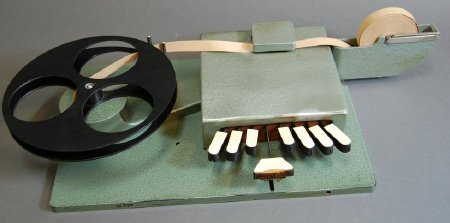Object ID:
2018.24
Title:
7-point Stenographic Braillewriter
Description:
(a) braillewriter: crackled gray-green enamel; aluminum castings; flat square chassis screwed to rectangular base; seven angled braille keys and trapezoidal space bar emerge from front of case, wooden pads with ivory plastic laminate on top, steel arms; diebox is concealed under small box screwed to top of case, paper release lever emerges from back of this box; stamped on front of the base, "10 237"; paper supply reel on right holds spool of 13 mm wide paper tape, reel swivels into side of case for storage; steel space bar support under key slides out to lock key as necessary; paper takeup reel on left with its works protected by an aluminum shield screwed to the base, the reel advances one space as keys are struck via a geared mechanism, two nickel plated rods mounted to the base guide the paper tape from the writer to the reel, copper paper clips fitted to the base of one of these rods; (bc) two plastic paper takeup reels, each with three large circles punched in sides and aluminum hub (stored in pocket in the case); (de) two blued-steel paper tape winding tools, crank-shaped, with hole and pin on bar; (f) extra spool of paper tape; (g) carrying case with hinged lid with two leather stays; hard plastic simulated leather exterior; lined with treated brown linen; compartment in lid to hold reels and accessores, orange foam pad; four rubber washers pinned to base secure braillewriter, brown plastic handle on swivel hardware, two nickel plated lockable latches on vinyl flaps on front; (h) case key.
Date:
ca. 1963
Made by:
Mechanische Werkstatt fur Blindenhilfsmittel
Place of Origin:
Leipzig, East Germany
Provenance:
The Mechanische Werkstatt fur Blindenhilfsmittel was the manufacturing arm of the Deutsche Zentralbücherei für Blinde(DZB) in Leipzig, East Germany after WWII. Paul Georgi, a WWII veteran, became director of the Werkstatt in 1961. Founded in 1894, the DZB is the oldest library for the blind in Germany. A version of this writer is pictured in a 1963 catalog (see file). The museum also holds a six-dot version (2014.12) from the same maker made without the left hand take-up reel.
In the years between World War I and World War II, stenography emerged as an important profession for blind typists in Germany, and several competing braille shorthand codes were published.
In the years between World War I and World War II, stenography emerged as an important profession for blind typists in Germany, and several competing braille shorthand codes were published.
Credit Line:
Museum Purchase, 2018.24.
